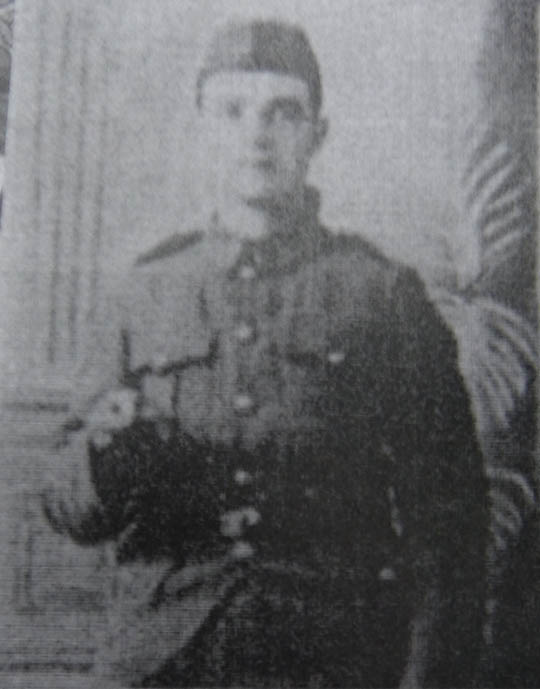
The countryside outside Courcelette, in France, is not particularly remarkable. The land rolls innocuously through farmyards, bluffs of trees and tiny rural villages where, this time of year, people are tilling the soil for planting.
Amid the oats, barley and rape seed that farmers are cultivating in this part of France, a family arrived from Canada, this past week. Near Courcelette, that family – equally unassumingly – came to a small cemetery last Sunday afternoon. One of its youngest members, Ryan Robertson, stood in the cemetery and did something unusual. He spoke in front of his family and some of his Uxbridge classmates about a cousin who died here in France 103 years ago.
“Oliver Barton arrived in the country in the summer of 1916,” said Ryan, reading from notes he’d prepared specially for the occasion. “Assigned to the 13th Battalion, on Oct. 8 (1916), Private Barton left his trench. But his battalion was practically wiped out by German machine-gun fire.”

Ryan, who turns 16 this month, doesn’t speak in public this way very often. But because one of his teachers at Uxbridge Secondary School, Tish MacDonald, invited him to research the stories of Canadian veterans and war dead, Ryan prepared the story of his first cousin three-times-removed – Pte. Oliver Robert Barton.
Then, last Sunday afternoon, as part of a Remembrance Tour he and his fellow USS students are taking through France, Belgium and Holland, Ryan recounted how Barton “did not answer the call the next day … Some weeks later his body was found three farm field to the east of here.”
But Ryan’s audience wasn’t all students last Sunday. Beside him were his grandparents, Lewis and Gayle Gregor (Oliver Barton was Gayle’s great uncle), and his parents Leanne and Jason Gregor (Uxbridge-based pilot and volunteer firefighter). But the Gregor family had other wartime history to share with the two bus coaches of students and other USS parents there that day at Adanac cemetery near Courcelette. A few rows of tombstones away, Ryan’s dad, Jason, offered the teenagers and adult history buffs another story.

Next to a gravestone identifying the remains of James Richardson, private and piper for the 16th Infantry (Canadian Scottish) Battalion, Jason Gregor recounted Richardson’s moment of inspiration and valour. On the morning of Oct. 9, 1916, Richardson’s Canadian Scottish comrades needed a final boost to lift them over the top in a rush to capture Regina Trench, near Courcelette. The men around him experienced doubt about what they’d face in no man’s land. Undoubtedly many were afraid. Suddenly, as Jason Gregor explained, piper Richardson approached his commanding officer.
“Sir, shall I give ’em some wind?” he asked.
“Yes. Give ’em some wind,” his CO answered. And piper Richardson, age 20, leapt to the top of the parapet and played his pipes to help his comrades out of their trenches. Then, the piper followed them into battle. It was one of the toughest days for Canadians during the battle of Ancre Heights – on average of 750 casualties per 1,000 men each assault that fall.
As the fighting subsided, Richardson brought a wounded comrade to safety, and then he turned back to retrieve his bagpipes. But he was never seen alive again and his pipes disappeared too. Richardson received a posthumous Victoria Cross.
“In 1917 a British chaplain found a set of bagpipes and they were taken to Scotland where the chaplain taught school,” Jason Gregor said. “It wasn’t until 2003 when the pipes were identified, returned to Canada and displayed.”

When Jason had finished his recounting of the story, a piper in the tour, one of the USS chaperones, Mike MacDonald, played a lament for piper Richardson. Off to one side, Lewis Gregor, dressed in regimental kilt, coat and cap, saluted. It’s only a year ago that members of the Gregor family decided they would make this historic trip to France. “We don’t think any member of our family’s ever been to Oliver’s grave,” Lew Gregor said.
It was an extraordinary day for the youngest members of the tour. Ryan Robertson and his fellow students of Uxbridge Secondary School realized they’d done something remarkable … in an unremarkable place. They’d literally touched history that’s a century old. And they’d likely never forget it.
 They had – by their physical presence – given Barton’s and Richardson’s century-old stories a lift by remembering them. They’d “given ’em some wind.”
They had – by their physical presence – given Barton’s and Richardson’s century-old stories a lift by remembering them. They’d “given ’em some wind.”
And by the way, those farmers I mentioned at the beginning of my column? Along with the farm fields they’ve been cultivating and planting, they’ve been conducting what’s called “the iron harvest.” Tucked up against the outside of the Adanac cemetery wall, our group found an artillery shell intact, that a farmer in the area must have uncovered in one of his fields – a leftover piece of ordnance from the Great War, and just another reminder, the darkness of war in Europe over a hundred years ago will not quickly go away.
We are so proud of our family, Gayle, Lew, Jason, Leanne, and Ryan for visiting and honouring Oliver Barton, our cousin. And thank you Ted Barris for this wonderful article.